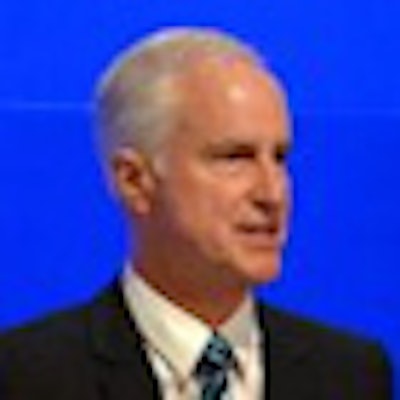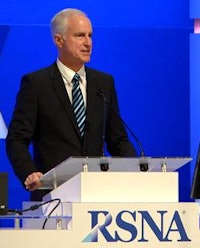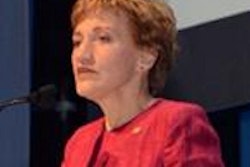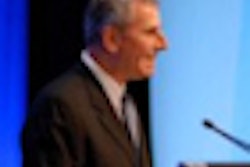
CHICAGO - "Step out from behind the curtain and put a face on the radiologist" was the resounding message of Sunday morning's opening session at the annual RSNA meeting. Dr. George Bisset III, RSNA president, emphasized the meeting's theme during his opening remarks and was echoed by colleagues in sessions that followed.
The phrases "put the patient first" and "become more visible" are often repeated in the radiology community, but Bisset, a pediatric radiologist from Houston, argued they must become a reality if radiology is going to weather the changes ahead. The looming Affordable Care Act as well as accountable care organizations and medical homes make it essential for radiologists to live by these two principles.
 Dr. George Bisset III, RSNA president.
Dr. George Bisset III, RSNA president.
These healthcare changes are movement toward value-based healthcare, with a focus on better health outcomes and lower costs. In this system, everyone is expected to show how they contribute to patients, he said.
"[A]fter a year of reflection about our profession, I now believe more firmly than ever that our future depends on our capacity to develop a new kind of shared ownership of our patients' needs and expectations, along with our primary care and specialty colleagues," he said.
"What I mean is owning our patients' problems," he said. "I mean being more fully invested in them, thinking of them as 'our' patients as much as anybody's -- owning their fears and their frustrations; owning their need for clear, understandable information; and owning their health behaviors and capacity to make good health-related decisions. I believe it's time to redefine what we mean by patient care, viewing it not so much as a product we deliver but as a virtue we live and breathe as we go about our daily duties."
Bisset sees the current healthcare chaos as a "golden opportunity." The changing environment of value-driven healthcare is an opportunity to address radiologists' invisibility. He advised paying attention to small details -- even relatively routine exams such as mammograms or chest radiographs may be alarming for some patients. Spend a little time in the waiting room and ask patients what can be done to improve the experience, he added.
To create a patient-centered practice it boils down to four principles, according to Bisset:
- Dignity and respect: Healthcare practitioners should listen and honor patient and family perspective and choices.
- Information sharing: Healthcare practitioners should communicate and share accurate, complete, timely, and unbiased information with patients and families in ways that are affirming and useful.
- Participation: Patients and families should be encouraged and supported in participating in care and decision-making at whatever level they choose.
- Collaboration: Patients and families should be included as partners on an institution-wide basis. Healthcare leaders should collaborate with patients and families in policy and program development, implementation, and evaluation. They should also collaborate in healthcare facility design, their professional education, and in the delivery of care.
"These are small steps, but they will go a long way in ensuring visibility in our profession, with our patients and our colleagues," he said. "And they'll get us well along the path of true patient ownership, becoming invested in and committed to our patients, not 'the' patients. You are the patient's doctor when it comes to imaging."
"By taking this path, we'll demonstrate to our patients that we care, we'll demonstrate to our colleagues our value as an integral part of the healthcare team, and we'll make a significant contribution at a time when the healthcare system needs us more than ever," he added.
In the two panels that followed, practical examples of patient-centered care were demonstrated. For example, "patients first" is the driving force behind facial transplants, for which imaging is essential. Years ago, patients' faces were "reconstructed"; now they're "restored" so patients can integrate into society and accomplish tasks most take for granted, such as smiling, said Dr. Bohdan Pomahac, burn director at Brigham and Women's Hospital.
Dr. Karen Arscott, an associate professor in clinical sciences at the Commonwealth Medical College in Pennsylvania, put forth an impassioned plea for radiologists to become more visible and to meet their patients. She is a cancer survivor as well as a doctor, so she understands what it means to be both a doctor and a patient.
"As a physician, I don't think any of us want to be the unnamed person in the background that the patients don't know," she said. "That's not why we went to medical school. We went to medical school to care for our patients."
Arscott went on to quote a 2008 article in the New England Journal of Medicine that said that for the clinician, the bedside is hallowed ground -- the place where fellow human beings grant physicians the privilege of looking at, touching, and listening to their bodies. The physicians' skills and discernment must be worthy of such trust.
"So my advice as a patient and as a colleague is: Face your fears," she concluded. "Meet your patients. Your patients want to meet you. And above all else, care for your patients."



















